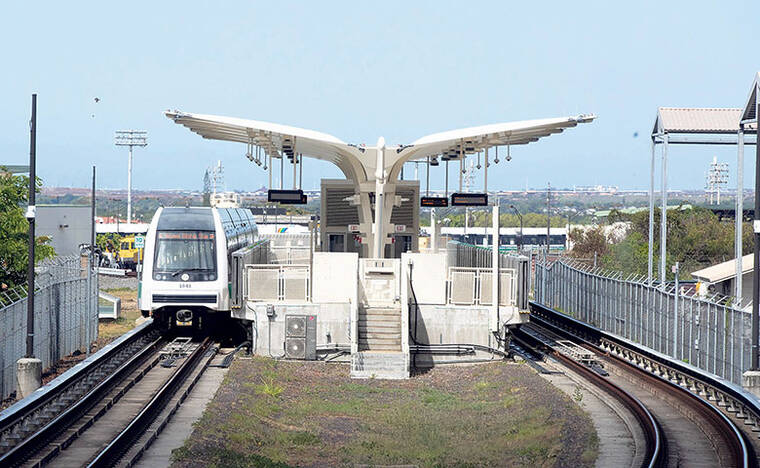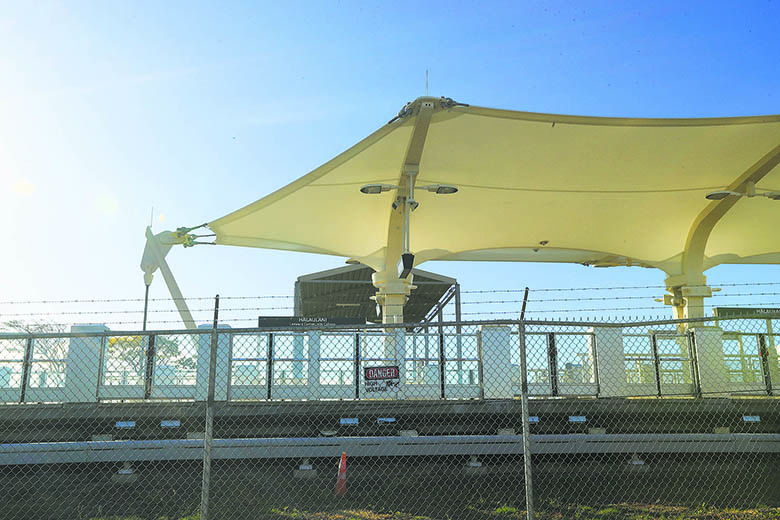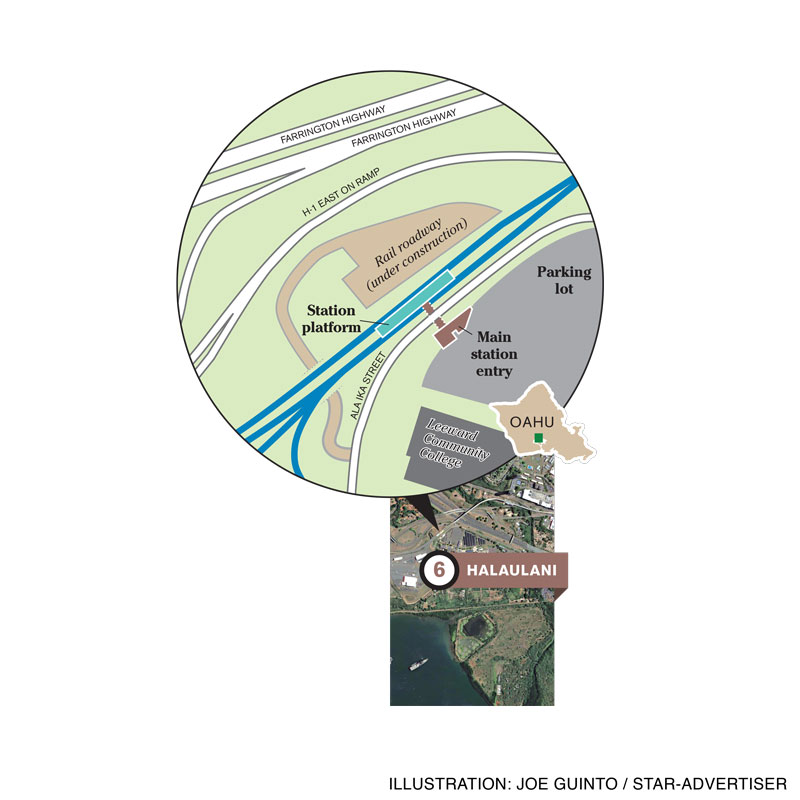Skyline: Honolulu rail station at LCC is unique and isolated



CINDY ELLEN RUSSELL / JUNE 22
THe westbound view of the Halaulani (Leeward Community College) station from inside Skyline.



EDITOR’S NOTE: The Honolulu Star-Advertiser is featuring each of the nine Skyline rail stations and surrounding communities stretching 11 miles from East Kapolei to Aloha Stadium. The series started Sunday and continues through Thursday. Passengers will begin riding Skyline on Friday.
———
The city’s rail station next to Leeward Community College is close to the middle of an initial 11-mile operating segment, but it’s also the most isolated.
This station, named after a historical place in the area called Halaulani between three ponds and an old government road, is expected to be the least used when the full transit line is running with 19 stations between East Kapolei and Kakaako.
Average daily passenger boardings are estimated to be 1,450 at Halaulani in 2030, according to the most recent Honolulu Authority for Rapid Transportation projection made in 2021, before the full system completion was pushed back to 2031.
By comparison, the busiest station was previously expected to be at Ala Moana Center with 17,330 daily boardings, but that station was cut from the project in 2022 due to funding limitations.
Don't miss out on what's happening!
Stay in touch with breaking news, as it happens, conveniently in your email inbox. It's FREE!
Among the other eight stations in the initial rail segment, HART’s projected 2030 boarding volume ranges from 2,440 at the University of Hawaii West Oahu to 9,680 at Pearl Highlands, the latter of which is a one-minute ride from LCC on the line.
The expected light use at Halaulani reflects the station’s location at a community college with relatively low enrollment and not much of a surrounding population.
“The Leeward Community College station is not expected to have the high passenger access demands of other station locations because it is physically isolated and will have neither a park-and-ride lot nor a bus transit center nearby,” a city transit-oriented development plan states.
The city will not have bus service to or from Halaulani, and a 1,200-stall parking lot next to the station is for LCC use only.

A canopy provides shade at the Halaulani (Leeward Community College) station.
Halaulani is also unique in a couple of other ways.
For one, it’s the only station at-grade in the city’s otherwise elevated system, recently named Skyline. Halaulani also is accessed through a short tunnel under Ala Ike Street that connects the station entryway next to LCC’s main parking lot to the station platform.
To be sure, Halaulani will benefit some LCC students and faculty as well as perhaps some nearby residents in the 119-unit College Gardens townhome complex adjacent to campus and a smattering of nearby single-family homes.
LCC’s student body is generally over 6,000 students, though enrollment has slid over the past seven years from about 8,000 in the early 2010s. About 450 staff work at the community college.
“We here at Leeward are looking forward to the rail service beginning,” said LCC Chancellor Carlos Penaloza. “It will provide another transportation option for many of our students, making higher education even more accessible to them, strengthening cross-campus collaboration and efforts.”
Yet the potential for broader rail use at Halaulani is tied to significant community growth around the station, and this is pretty hemmed in by geographical barriers.
Halaulani is bordered on the mauka side by a twisted mess of roads making up the H-1/H-2 freeway interchange. Just makai are a few farms and the Pearl Harbor National Wildlife Refuge. On the Ewa side of the station is HART’s rail yard and operations center. Toward Diamond Head beyond H-1 lies Pearl City, served by other rail stations.
The city’s transit-oriented development plan for the area envisions redeveloping portions of LCC’s campus, mainly large surface parking lots, into a small college-oriented neighborhood with perhaps 820 homes.
However, UH has no plan to pursue community development at LCC, though it would be open to discussions that could include potentially selling land for development, according to university spokesperson Dan Meisenzahl.
“The university will be open to any ideas regarding the property and its campus to better serve the community,” he said.
Elements in the city’s conceptual plan illustrating potential redevelopment at the 27-acre campus include additions of primarily low-density housing on the site of an overflow parking lot on the Diamond Head side of LCC, and a medium-density mix of residences, offices, restaurants and convenience-oriented retail served by two new parking structures where the main parking lot exists today.
Other pieces include a central park, some new surface parking on the mauka side of the station platform now partly occupied by a Hawaiian Electric substation, and a pedestrian plaza fronting the station entry plaza between LCC and the envisioned mixed-use development.
“Creating a strong connection between transit and the college will make riding the train an attractive alternative to driving to LCC, potentially freeing up a portion of the current surface parking area for higher and better uses,” the city’s plan states.
RELATED
• Skyline: Honolulu rail rolls out after years of delays, cost overruns
• Skyline: Honolulu’s new rail line begins in East Kapolei
• Skyline: Interactive timeline of Honolulu’s rail system
• Skyline: How to ride Honolulu’s rail system for the first time
• Skyline: 2nd station is sandwiched by UH campus, Ho‘opili growth
• Skyline: Rail station surrounded by farming is years away from major use
• Skyline: West Loch station offers alternative to Ewa Beach traffic
• Skyline: Waipahu station stands out amid automobile businesses
• Skyline: Honolulu rail station at LCC is unique and isolated
• Skyline: Pearl Highlands line disconnected from Central Oahu
• PHOTOS: Take a look back at Honolulu’s rail construction
• PHOTOS: Honolulu Skyline’s first 9 rail stations ready to roll
• Click here to view previous rail coverage.

Halaulani (Heavenly halau, chief’s house, name of a star). Halaulani is an ‘ili situated between the ponds of Hanaloa, Eo and Hanapouli, and the government road. There was situated in the land of Halaulani, the heiau called Ahu‘ena or Ha‘ena, which was used in the time of Kamehameha I, and last cared for by John Papa ‘I‘i, who was granted fee-simple interest in the land during the Mahele.



